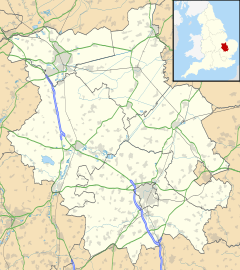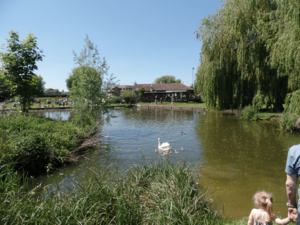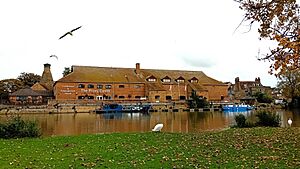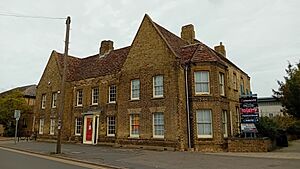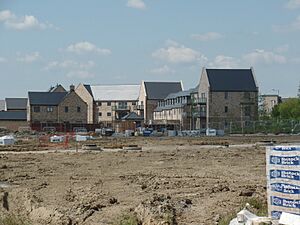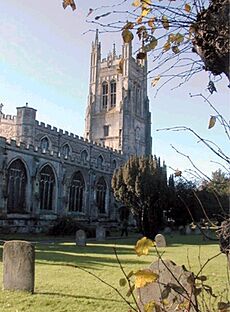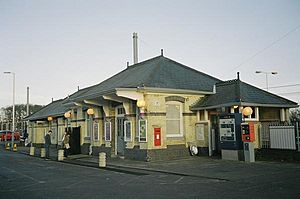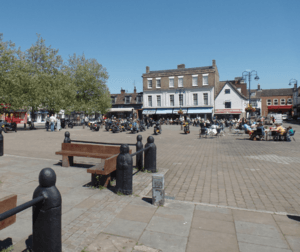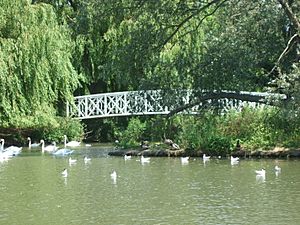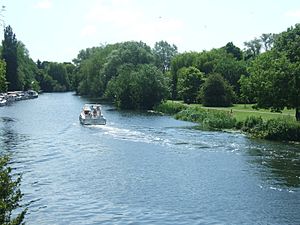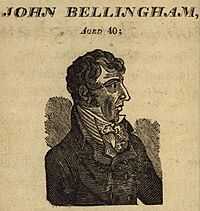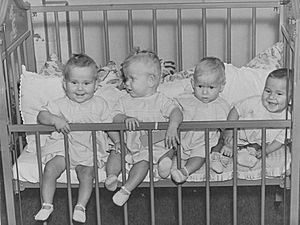St Neots facts for kids
Quick facts for kids St Neots |
|
|---|---|
| Town and civil parish | |
Aerial view of St Neots |
|
| Area | 8.12 km2 (3.14 sq mi) |
| Population | 33,410 (Parish, 2021) 33,265 (Built up area, 2021) |
| OS grid reference | TL185605 |
| • London | 49 miles (79 km) S |
| Civil parish |
|
| District | |
| Shire county | |
| Region | |
| Country | England |
| Sovereign state | United Kingdom |
| Post town | ST NEOTS |
| Postcode district | PE19 |
| Dialling code | 01480 |
| Police | Cambridgeshire |
| Fire | Cambridgeshire |
| Ambulance | East of England |
| EU Parliament | East of England |
| UK Parliament |
|
St Neots is a lively town in Cambridgeshire, England. It's about 18 kilometers (11 miles) west of the famous city of Cambridge. The town sits right by the beautiful River Great Ouse.
St Neots includes several areas like Eynesbury, Eaton Ford, Eaton Socon, and Wintringham. It's easy to get to St Neots because it's close to major roads like the A1, A421, and A428. There's also a train station, St Neots railway station, which connects to London and Peterborough. In 2021, about 33,410 people lived in St Neots.
Contents
- What's in a Name? The Story of St Neots
- A Look Back: St Neots Through Time
- Fun and Community in St Neots
- How St Neots is Governed
- Growing St Neots: Homes and Management
- Sports and Fun Activities
- St Neots Parish Church
- News and Entertainment
- Getting Around: Transport in St Neots
- St Neots' Location and Environment
- International Friends
- Famous People from St Neots
- See also
What's in a Name? The Story of St Neots
The town of St Neots gets its name from a special person: Saint Neot. He was a monk who lived in the 800s. Around the year 980 AD, his bones were brought to a place called St Neots Priory from Cornwall.
Many people, called pilgrims, came to visit the priory because of Saint Neot's bones. They believed he was a holy person. Before the priory was built, this area was part of a village called Eynesbury. As the town around the priory grew, it became its own separate area called St Neots in the 1100s. Later, in 1876, Eynesbury became part of St Neots again.
A Look Back: St Neots Through Time
Ancient Times and Early Settlements
People have lived in the St Neots area for a very long time! We know this because tools and signs of Iron Age settlements have been found in the town. The Romans also had a camp here. The area was first known as Eynesbury, named after a local leader called Ernulf.
The Monk and the Priory
Saint Neot was a holy man who started a monastery in Cornwall. After he died, his remains were kept there. Many pilgrims visited, bringing money to the monastery. Later, in the 900s, a priory was built near Eynesbury. The landowners, Leofric and Leoflaed, brought Saint Neot's remains (except for one arm) to their new priory. They knew this would attract more pilgrims and their money.
Their plan worked! The priory became very rich and famous, and the area became known as St Neots. This led to St Neots becoming a separate parish from Eynesbury between 1113 and 1204.
Villages by the River
Around the same time, a settlement west of the River Ouse was called Ea-tun, meaning "waterside village." Later, it became known as Eaton Socon. Before bridges were common, people would walk across the shallow parts of the river, called a "ford." This is how the area of Eaton Ford got its name.
The priory was destroyed in the 1500s during a time called the Dissolution of the Monasteries, and Saint Neot's remains were lost.
Trade and Transport
In 1629, the River Great Ouse was made easier for boats to travel on, from St Ives to Bedford, passing through St Neots. This helped the town with trade.
During the Second English Civil War in 1648, a battle happened in St Neots. Soldiers loyal to King Charles I (Royalists) were resting in the town. Early on July 10th, Parliament's troops, led by Oliver Cromwell's forces, attacked them by surprise. The fighting was mostly around the market square. Many Royalists were killed or captured.
In the 1700s and 1800s, St Neots became wealthy from grinding corn, brewing, and from stagecoach traffic. In 1850, the railway arrived, bringing even more business. Eaton Socon, a part of St Neots, was on the Great North Road. This meant many stagecoaches stopped there on their way between London and York.
From 1851 to 1885, a large factory called Vulcan Iron Foundry, owned by George Bower, was a major employer. It made equipment for gasworks all over the world.
St Neots in the 1900s and Today
In 1965, Eaton Ford and Eaton Socon, which used to be in Bedfordshire, became part of St Neots.
Today, St Neots has modern industries, including technology companies and the Little Barford Power Station nearby.
The town has grown a lot recently. New housing areas like Love's Farm and Wintringham have been built. Wintringham is planned to be a lively community with 2,000 homes and two primary schools. More developments are planned, like Monkfields, which will bring even more homes to the area.
Fun and Community in St Neots
St Neots Museum is located in the old Victorian Police Station. It shows the town's history, including a display about James Toller, the "Eynesbury Giant," who was over 8 feet tall! The museum also has art exhibitions and organizes events like walks and festivals.
You can find a general market in the market square every Thursday. There's also a farmers market on the second and fourth Saturday of each month.
St Neots has a lively theatre scene with groups like the Riverside Theatre Company, VAMPS, and St Neots Players. They put on plays, musicals, and workshops for all ages. Stageworks offers performing arts classes and training.
The local creative community, called Neotists, helps artists, designers, and photographers connect and work together. In 2023, they organized the St Neots Festival, a music and arts event in Priory Park.
How St Neots is Governed
St Neots has three levels of local government:
- St Neots Town Council: This is the local council for the town itself.
- Huntingdonshire District Council: This council covers the wider district.
- Cambridgeshire County Council: This council covers the entire county.
These councils also work together as part of the Cambridgeshire and Peterborough Combined Authority.
The town council works from the Priory Centre, which is by the River Great Ouse. It has 21 elected councillors, including a town mayor. The council manages things like cemeteries, public toilets, play areas, and some bus shelters.
A Brief History of Local Government
For a long time, St Neots was managed by its local church group, called a "vestry." In 1819, a special group of "improvement commissioners" was set up to manage the more built-up parts of the town. Later, in 1876, this group became a "local government district" and included parts of Eynesbury.
In 1894, these districts became "urban districts." The St Neots Urban District grew in 1965 to include Eaton Socon and Eaton Ford.
In 1938, the urban district council bought Cressner House to use as its offices. In 1974, the urban district was replaced by the new Huntingdon District Council. St Neots then became a "successor parish," which means it kept its own town council and mayor. In 1989, the town council moved to new offices in the Priory Centre.
Who Represents St Neots in Parliament?
St Neots is part of the St Neots and Mid Cambridgeshire area for the UK Parliament. The current Member of Parliament (MP) is Ian Sollom from the Liberal Democrats.
Growing St Neots: Homes and Management
St Neots has grown a lot since the 1960s. Many new homes were built for families moving from London as part of a plan to help with overcrowding. More houses continue to be built, especially in areas like Love's Farm and Wintringham.
The population of St Neots was about 31,165 in 2011 and grew to around 33,000 in 2021. This number is expected to keep rising. St Neots is a good place for growth because it's a traditional town with many industrial areas and good transport links.
The town will also receive £12.8 million from the Government's Future High Streets Fund to improve its town centre.
Sports and Fun Activities
St Neots has many sports teams and leisure activities:
- Football: St Neots Town F.C. is a semi-professional football team that plays at Rowley Park Stadium.
- Rugby: There's a rugby club called St Neots RUFC.
- Rowing: You can join the St Neots Rowing Club.
- Dragon Boating: The town has two Dragon Boat teams.
- Table Tennis: There's also the St Neots Table Tennis club.
The Huntingdonshire District Council runs a leisure centre in Eynesbury. It has an indoor swimming pool, gym, squash courts, sports hall, and tennis courts.
The River Great Ouse is perfect for walks along its banks, especially in Regatta Meadows and Riverside Park. It's also part of the Ouse Valley Way walking route.
Riverside Park is a large park near the town centre, covering about 72 acres. It has a cafe, a big play area for children, a skate park, and a miniature railway called Riverside Miniature Railway. Sometimes, concerts are held in the park during the summer.
Barford Road Pocket Park in Eynesbury hosts weekly parkrun events, which are free, timed runs for everyone.
North of the town is Paxton Pits Nature Reserve. It's a great place for walks through lakes, meadows, and woodlands. It's famous for its nightingales and cormorants, and many other birds, insects, and plants live there.
The Rowley Arts Centre, opened in 2014, has a six-screen Cineworld cinema, restaurants, and a gym. It was named after Peter Rowley, who donated money for its development.
St Neots also has a 16-lane ten-pin bowling centre. There are discussions about building a splash park on the remaining part of the site where an outdoor pool used to be.
For golf lovers, there are two courses: St Neots Golf Club and Wyboston Lakes.
St Neots Parish Church
St Neots' main church is called St Mary's Parish Church. It was mostly rebuilt in the 1400s, making it one of the biggest and most beautiful medieval churches in Cambridgeshire. In the 1800s, it got stunning stained glass windows that show scenes from the life of Jesus Christ. Many people consider it a very impressive building, sometimes called the "Cathedral of Huntingdonshire."
The writer John Betjeman described it in 1958 as "almost everything a good town church should be." He praised its "finest tower in the county" and its beautiful design.
News and Entertainment
For local news and TV, St Neots gets programmes from BBC East and ITV Anglia.
Local radio stations include BBC Radio Cambridgeshire, Heart East, Greatest Hits Radio East, Star Radio, HCR FM, and Black Cat Radio.
The Hunts Post is the town's local weekly newspaper.
Getting Around: Transport in St Neots
Train Travel
St Neots railway station has trains every half hour. You can go north to Peterborough or south to Horsham, passing through London St Pancras and Gatwick Airport. During busy times, there are extra trains to and from London King's Cross. A trip to London King's Cross usually takes about 45 minutes.
The station's footbridge connects to the car park and taxi stand on one side, and the Love's Farm area on the other. There are lifts to the platforms.
There are plans for a new railway line called East West Rail to connect Oxford and Cambridge. This new line might include a station at Tempsford, south of St Neots.
Road Connections
St Neots is right next to the A1 trunk road, which connects the town to London, the northeast of England, and Scotland. The A428 road links St Neots to Cambridge, and the A421 road connects to Bedford and Milton Keynes.
About six miles north, the A14 trunk road provides access to the Midlands and East Anglia.
Historically, the Great North Road (which is now the A1) used to go through Eaton Socon. But a new bypass for the A1 opened in 1971, taking traffic around the town.
The A45 road used to go through the town centre, but a 3-mile St Neots Bypass opened in 1985 (now called the A428). A big new road project is also underway to connect the Black Cat roundabout and the A428 at Caxton Gibbet, which will help traffic avoid St Neots completely.
Bus Services
St Neots has bus services that connect it to other towns. The Stagecoach 905 bus runs between Bedford and Cambridge about every half hour.
The Whippet Bus Company operates a local circular service (61/63) that goes through the town centre, Eaton Ford, Eaton Socon, Eynesbury, and the railway station. This bus runs about every hour, six days a week. Whippet also runs a 66 bus service between St Neots and Huntingdon.
Air Travel
St Neots is less than an hour's drive from London Luton Airport and London Stansted Airport. You can also take a direct train from St Neots to London Gatwick Airport.
Cycling Paths
St Neots is on Route 12 of the Sustrans national cycle route. This route connects many towns, including Colchester, Oxford, Cambridge, and Milton Keynes.
A special bridge for walking and cycling across the River Great Ouse opened in 2011. It links Eaton Socon and Eynesbury, making it safer for students to cycle to Ernulf Academy and improving connections to other cycle paths.
St Neots' Location and Environment
St Neots is about 79 kilometers (49 miles) north of Charing Cross in London. It's located near the edge of the Huntingdonshire district and close to the border with Bedfordshire. Both Cambridge (about 18 miles east) and Bedford (about 13 miles southwest) are nearby.
St Neots sits in the valley of the River Great Ouse. Parts of the town are on the flood plain (flat land that can flood), and other parts are on slightly higher ground. The Great Ouse is a wide river that is now controlled by weirs and sluices.
Smaller rivers and streams, like the River Kym and Hen Brook, flow into the Great Ouse in St Neots. The area is generally low and flat. Riverside Park, near St Neots Bridge, is kept as a flood-meadow. This means it's allowed to flood, which helps protect homes and businesses from high river levels.
St Neots grew up around a ford, which was a shallow place where people could cross the river. This ford was later replaced by a medieval bridge. Today, there are two more river crossings just outside the town.
The soil in the area is mostly light, with gravel beds underneath. Extracting gravel is a local industry. Old gravel pits, like Paxton Pits and Wyboston Leisure Park, have been turned into nature reserves and recreational areas. Away from the river, the higher land has heavy clay soil and is mostly used for farming crops.
Weather in St Neots
The climate in the United Kingdom is a temperate oceanic climate, which means it has mild temperatures and rain throughout the year. Eastern parts of the UK, like Cambridgeshire, are usually drier, cooler, and less windy. They also have bigger differences between daily and seasonal temperatures. Cambridgeshire is warm in summer and cold and frosty in winter.
In 2020, the highest daytime temperature was 22°C and the lowest was 5°C. Night-time temperatures ranged from 15°C to -1°C. Rainfall varied between 21 and 41 mm per month, with more rain in the summer. There was some snowfall in December 2020 and in January and April 2021.
International Friends
St Neots is twinned with Faches-Thumesnil, a town in France. This means they have a special friendship and often exchange visits.
Famous People from St Neots
- Winifred Crossley Fair: She was a brave aviator and one of the first eight women pilots to join the Air Transport Auxiliary during World War II. She was the first woman to fly a Hurricane fighter plane.
- The St Neots Quads: These quadruplets are famous because they were the first British quadruplets to survive more than a few days. As of 2021, they were the oldest quadruplets in the world!
- Mark Foster: A multiple World short course swimming champion, he lives in St Neots.
See also
 In Spanish: Saint Neots para niños
In Spanish: Saint Neots para niños


